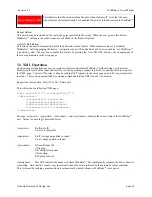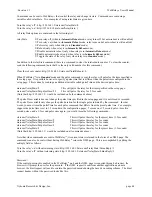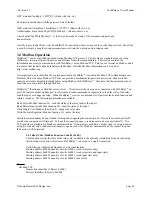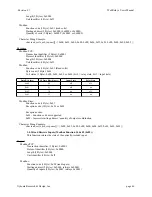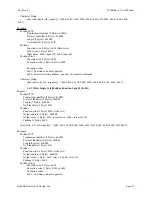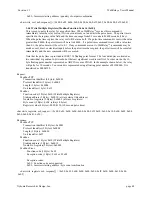
Revision 3.1
WebRelay
TM
Users Manual
-
remote command equals local relay
-
This option is used to “daisy-chain” WebRelay
TM
units. In
this mode, commands are sent to the remote WebRelay
TM
based upon the state of the local
relay and not the local input. When the local relay changes state to
on,
a command is sent
to the remote WebRelay
TM
to set the relay state to
on
. When the local relay changes state
to
off
, a command is sent to the remote WebRelay
TM
to set the relay state to
off
.
15. Remote Relay IP Address:
When any option in the ‘Remote Relay Options’ setting is selected other than
no remote relay
control
, commands are sent over the IP network to this address as the control voltage input
changes.
16. Remote TCP Port:
When any option in the ‘Remote Relay Options’ setting is selected other than
no remote relay
control
, commands are sent over the IP network to this TCP port on the remote WebRelay
TM
as the
control voltage input changes.
17. Relay #:
When any option in the ‘Remote Relay Options’ setting is selected other than
no remote relay
control
, commands are sent to the remote device with this relay offset. This option should
ALWAYS be set to 0, unless the remote device is something other than WebRelay
TM
. This is used,
for example, when the remote device has multiple relays. For example, WebRelay-Quad
TM
has 4
relays. To send commands to third relay on WebRelay-Quad
TM
, this option would be set to 3. To
send commands to the first relay on WebRelay-Quad
TM
, this option would be set to 1.
For a more technical description of this option, commands sent to remote WebRelay
TM
units look
like this...
http://192.168.1.2/state.xml?relayState=1
When a 0 is entered into this field, the above format is used which is required for standard
WebRelay
TM
units.
Commands sent to a remote WebRelay-Quad
TM
look like this...
http://192.168.1.2/state.xml?relay
1
State=1
http://192.168.1.2/state.xml?relay
2
State=1
...
http://192.168.1.2/state.xml?relay
4
State=1
In this case, each of the four relays can be addressed as illustrated. The address of the specific relay
on the WebRelay quad board is given in this field.
For custom computer applications, the ‘Relay #’ option may be useful to monitor input changes as
they happen. This works by pointing the ‘Remote Relay IP Address’ above, to a computer instead
of another WebRelay
TM
device. Each time the input changes, a message is sent to the computer
indicating the change. The computer can identify the device sending the message by the ‘Relay #’.
Note that when remote relay commands are sent to a computer instead of a WebRelay
TM
, the
computer must appear to this WebRelay
TM
as another WebRelay
TM
device which may require some
advanced programming.
This field may be set from 0 to 255.
18. Password:
When any option in the ‘Remote Relay Options’ setting is selected other than
no remote relay
control
, this password is included with commands that are sent to the remote WebRelay
TM
unit. If
the remote WebRelay
TM
unit has the control password option enabled, the password for that unit
must be entered here for the remote commands to have any effect.
19. Keep Alive:
When any option in the ‘Remote Relay Options’ setting is selected other than
no remote relay
Xytronix Research & Design, Inc.
page 33

























